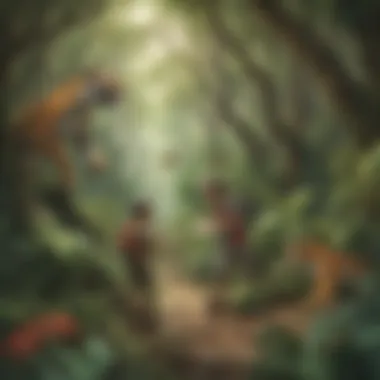Engaging Animal Habitat Activities for Inquisitive Young Minds


Fun Activities Concepts
Engaging children with animal habitat activities can be a enriching and delightful experience. Stimulating their inquisitiveness through hands-on projects and interactive games not only entertains but also educates. Let's explore various ideas to captivate young minds.
Indoor Activities
Indoor activities offer a perfect opportunity to delve into the wonders of animal habitats. Set up a mini jungle within your living room using cardboard and paint to create a habitat diorama. Encourage kids to populate the habitat with their toy animals, fostering creativity and imagination. Utilize online resources to learn about different animal environments from the comfort of home.
Outdoor Adventures
The great outdoors provide a vast canvas for discovering animal habitats in their natural setting. Take nature walks in nearby parks or nature reserves to observe animals in their habitats. Challenge children to identify different habitats such as forests, ponds, or deserts during these outdoor excursions. Consider birdwatching or even setting up a makeshift bird feeder to attract local avian species to your backyard.
Arts and Crafts
Unleash the artistic potential of young minds by incorporating arts and crafts activities centered around animal habitats. Create papier-mâché animals native to particular habitats or design habitat-themed terrariums using recycled materials. Engaging in such craft projects not only enhances artistic skills but also imparts valuable knowledge about animal habitats and ecosystems.
Science Experiments
Introduce children to the scientific aspects of animal habitats through interactive experiments. Construct mini ecosystems in jars to demonstrate how various elements like soil, plants, and water interact to support life. Conduct simple experiments to showcase the effect of habitat destruction on living organisms, emphasizing the importance of conservation and preservation.
Cooking Baking
Culinary exploration can also offer insights into animal habitats. Prepare snacks or meals inspired by animals from different habitats, incorporating educational elements into everyday cooking. Baking habitat-themed cookies or cakes can further immerse children in the world of animal habitats while honing their culinary skills.
Educational Games
While having fun, children can also engage in educational games that deepen their understanding of animal habitats.
Math and Logic Games
Integrate math and logic challenges into games related to animal habitats. Create puzzles that require players to match animals with their appropriate habitats based on specific characteristics or features. By incorporating mathematical concepts like sorting and categorizing, children enhance their cognitive skills while learning about different habitats.
Language and Vocabulary Games
Promote language development through engaging games focused on animal habitats. Word searches, crossword puzzles, or even habitat-themed storytelling sessions can enhance vocabulary and linguistic skills. Encouraging children to describe habitats using vivid language expands their communication abilities while fostering a deeper appreciation for wildlife.
STEM Activities
Explore the amalgamation of science, technology, engineering, and math (STEM) through activities related to animal habitats. Build model habitats using basic engineering principles or utilize digital platforms to simulate virtual habitat explorations. Introducing children to STEM concepts in the context of animal habitats promotes critical thinking and problem-solving skills.
History and Geography Puzzles
Unravel the historical and geographical aspects of animal habitats through engaging puzzles. Integrate historical narratives about habitat conservation efforts or organize geography quizzes focusing on various ecosystems around the globe. By linking historical and geographical contexts to animal habitats, children gain a holistic understanding of environmental dynamics.
Interactive Learning Apps
Leverage interactive learning apps to immerse children in the world of animal habitats. Utilize educational apps that offer virtual tours of different habitats, interactive quizzes on wildlife conservation, or digital storytelling experiences. These apps not only entertain but also educate, making learning about animal habitats a dynamic and engaging process.
Seasonal and Holiday Activities
Incorporate the spirit of seasons and holidays into activities that highlight animal habitats, fostering a sense of celebration and learning.


Valentine's Day Crafts
Celebrate Valentine's Day by creating crafts that emphasize love for nature. Engage children in crafting heart-shaped bird feeders or habitat-themed valentines to promote appreciation for wildlife. These activities not only celebrate the holiday but also instill a sense of compassion for animals and their habitats.
Halloween Costume Ideas
Inspire creativity during Halloween by encouraging habitat-themed costumes. From jungle explorers to marine biologists, children can dress up as defenders of animal habitats, sparking conversations about conservation and biodiversity. Craft homemade costumes featuring animal-inspired elements to ignite imagination and environmental stewardship.
Thanksgiving Cooking Projects
During Thanksgiving, engage in cooking projects that resonate with the essence of animal habitats. Prepare dishes using seasonal produce or ingredients inspired by animals from different habitats. Encourage children to research how various cultures incorporate nature's bounty into traditional Thanksgiving meals, fostering culinary curiosity and ecological awareness.
Christmas Decorations
Infuse the holiday season with elements inspired by animal habitats through interactive decoration projects. Create habitat-themed ornaments or craft DIY wreaths using natural materials like pinecones and twigs. By adorning the home with nature-inspired decor, children develop a deeper connection to wildlife while celebrating the festive season.
New Year's Resolutions for Kids
Embrace the new year with resolutions that prioritize environmental consciousness and habitat preservation. Encourage kids to commit to eco-friendly practices like reducing waste, conserving water, or participating in habitat restoration initiatives. By instilling a sense of environmental responsibility from a young age, children cultivate a lifelong commitment to protecting animal habitats.
Parenting Tips and Resources
Empower parents with valuable insights and resources to support children in exploring animal habitats effectively.
How to Encourage Creativity
Nurture creativity by providing children with opportunities to express themselves through art and play. Encourage imaginative storytelling or habitat-inspired drawings to stimulate creative thinking and innovation. Offer praise and feedback to cultivate a supportive environment that nurtures children's creative endeavors.
Setting up a Playful Learning Environment
Create a conducive environment that fosters playful learning when exploring animal habitats. Designate a dedicated space in the home for habitat-themed activities, equipped with educational resources and materials. Incorporate elements of nature like plants or natural light to inspire curiosity and engagement in learning.
Balancing Screen Time and Playtime
Strike a balance between digital exposure and hands-on play when engaging children in animal habitat activities. Limit screen time by encouraging outdoor exploration or interactive games that promote physical activity. Emphasize the importance of experiential learning through direct engagement with nature to cultivate a holistic understanding of animal habitats.
Building Strong Family Bonds
Strengthen family bonds by involving parents and guardians in animal habitat exploration activities. Encourage family outings to nature reserves or wildlife sanctuaries to experience firsthand encounters with diverse habitats. Engaging in collaborative projects that focus on habitat conservation fosters unity and teamwork among family members, creating lasting memories and emotional bonds.
Motivating Kids to Stay Active
Promote an active lifestyle by integrating physical activities into animal habitat exploration. Organize nature hikes, scavenger hunts, or outdoor games that challenge children physically while immersing them in natural surroundings. By instilling a love for outdoor activities, children develop a sense of stewardship towards animal habitats and environmental conservation.
Fun Facts and Trivia
Enrich the learning experience with intriguing facts and trivia about animals, habitats, and the natural world.
Animal Kingdom Discoveries
Explore fascinating aspects of the animal kingdom through mind-boggling facts and discoveries. Uncover unique animal adaptations to different habitats, from camouflaging organisms to extreme survival strategies. Engage children with tales of animal resilience and biodiversity that inspire a profound admiration for wildlife.
Famous Inventions Stories


Discover the intersection of innovation and animal habitats through famous inventions stories. Delve into inventions inspired by nature, such as biomimetic designs based on animal habitats. Unravel the stories behind groundbreaking inventions that have revolutionized habitat conservation and wildlife protection.
Historical Events for Kids
Illuminate historical events through the lens of animal habitats to offer a contextual understanding of environmental dynamics. Narrate compelling stories of conservationists and explorers who pioneered efforts to safeguard animal habitats. Connect historical events like wildlife reintroductions or habitat restoration projects to contemporary conservation challenges, highlighting the importance of preserving biodiversity.
Mythical Creatures Explorations
Embark on mythical journeys by exploring legendary creatures associated with different habitats. Unearth folklore and mythologies featuring creatures like dragons, unicorns, or mermaids that inhabit diverse environments. Stimulate children's imagination by drawing parallels between mythical creatures and real-life animals, fostering a sense of wonder and curiosity about the natural world.
Space Adventures and Discoveries
Expand horizons by venturing into the realm of space adventures and discoveries related to animal habitats. Learn about extraterrestrial habitats on other planets or celestial bodies and the possibility of life beyond Earth. Engage in discussions about space exploration's impact on understanding terrestrial habitats, inspiring children to ponder the vastness of the universe and its interconnected ecosystems.
Introduction to Animal Habitats
In delving into the realm of animal habitats, we embark on a fascinating journey of discovery and learning. At the core of this exploration lies the fundamental concept of ecosystem dynamics, wherein various organisms interact within their environments to form complex webs of life. Understanding these ecosystems provides invaluable insights into the delicate balance of nature and the interconnectedness of living beings. Through observing how animals adapt to their habitats, children can develop a profound appreciation for the diversity of life on our planet.
Understanding Ecosystems
Exploring Food Chains
One of the key elements within ecosystems is the intricate system of food chains. These chains depict the flow of energy and nutrients from one organism to another, illustrating the interdependent relationships in nature. By exploring food chains, children can grasp the concept of predator-prey dynamics and the essential role each creature plays in maintaining ecological harmony. Understanding food chains is crucial for comprehending the ripple effects of environmental changes and human activities on wildlife populations.
: Desrcibe the unqiue feature: 0f f00d chains and it' s avantages
Importance of Biodiversity
Another crucial aspect within ecosystems is biodiversity, referring to the variety of species coexisting in a particular habitat. Biodiversity fosters resilience in ecosystems, ensuring stability and adaptability in the face of challenges. It enriches the environment with genetic diversity, offering multiple solutions to environmental changes. Recognizing the importance of biodiversity instills in children a sense of stewardship towards preserving the rich tapestry of life on Earth.
Types of Habitats
Forests and Woodlands
Forests and woodlands represent unique habitats teeming with diverse flora and fauna. These habitats support a plethora of species, from towering trees to hidden insects, forming intricate ecological communities. Exploring forests and woodlands unveils the beauty of symbiotic relationships and the role each organism plays in sustaining the ecosystem. Children can learn about the cycle of life in these habitats and the interconnectivity that defines their equilibrium.
Grasslands and Prairies
: D!scuss the splcific aspects of Grassl4nds and Pra*ries anf it' s contriburyion to ovarall Pakari or goal
Grasslands and prairies spread vast expanses of open spaces, dotted with unique plants and roaming grazers. These habitats showcase the adaptations of animals to wide, open landscapes and the seasonal changes that influence their behaviors. Exploring grasslands and prairies introduces children to the resilience of species thriving in dynamic environments, facing challenges like droughts and fires.
Oceans and Marine Life
The oceans and marine life offer a mysterious realm filled with myriad creatures, from microscopic plankton to massive whales. These habitats cover over two-thirds of the Earth's surface, harboring diverse ecosystems that sustain life on a global scale. Discovering oceans and marine life plunges children into the wonders of underwater worlds, emphasizing the fragility of these environments and the necessity of conservation efforts to protect marine biodiversity.
Hands-On Projects
Hands-On Projects play a crucial role in engaging children with the fascinating world of animal habitats. By bringing theoretical knowledge into practical application, Hands-On Projects help young learners cement their understanding of ecosystems and biodiversity. These projects provide a hands-on experience that goes beyond traditional learning methods, allowing children to immerse themselves in the intricacies of different habitats. Through tactile exploration and creative expression, children develop a profound appreciation for the delicate balance of nature.
Creating a Miniature Habitat
Materials Needed


When embarking on the journey of Creating a Miniature Habitat, gathering the necessary materials is paramount. Common items like soil, pebbles, small plants, and miniature figurines are essential for crafting a realistic habitat. These materials contribute to the overall authenticity of the project, allowing children to mimic real-life ecosystems on a smaller scale. Incorporating natural elements into the miniature habitat enables kids to witness firsthand the components that make up a thriving environment. Despite their simplicity, these materials play a significant role in sparking the curiosity and imagination of young minds in this article.
Step-by-Step Guide
Guiding children through the process of creating a miniature habitat is an enriching experience. The Step-by-Step Guide breaks down the construction of the habitat into manageable tasks, ensuring that each stage is comprehensible and engaging for the young participants. From laying the foundation with soil to adding vegetation and arranging the figurines, the guide meticulously outlines every step to achieve a realistic and visually appealing habitat. This structured approach not only develops children's organizational skills but also cultivates their attention to detail and patience. While the guide simplifies the complex task of habitat creation, it also instills a sense of accomplishment and pride in the young eco-enthusiasts involved in this article.
Building a Bird Feeder
Choosing the Right Design
Selecting an appropriate design for a bird feeder is crucial in attracting diverse avian species. The design should consider factors such as bird species in the area, feeder accessibility, and ease of maintenance. Opting for a simple yet sturdy design ensures durability and functionality, providing a safe feeding environment for feathered visitors. By incorporating features like perches, a protective roof, and easy-to-clean mechanisms, the chosen design enhances birds' feeding experience while facilitating observation for young enthusiasts. The right design not only attracts a myriad of birds but also adds an aesthetic element to outdoor spaces, promoting a harmonious coexistence between wildlife and humans in this article.
Feeding Tips
Providing proper nourishment is vital for the health and well-being of feathered friends frequenting the bird feeder. Feeding Tips encompass aspects such as seed selection, feeder placement, and hygiene practices. Offering a variety of seeds ensures nutritional diversity for birds, catering to their specific dietary needs. Placing the feeder in a safe and accessible location shields birds from predators and adverse weather conditions, fostering a comfortable feeding environment. Regular cleaning and maintenance of the feeder prevent contamination and spread of diseases among avian visitors, promoting their overall health. By following these feeding tips, children actively contribute to supporting local bird populations and cultivating a sense of responsibility towards wildlife conservation in this article.
In this comprehensive guide aimed at engaging young minds in the wonders of animal habitats, the section on Interactive Games and Activities plays a pivotal role. Interactive games serve as a bridge between theoretical knowledge and practical understanding. By immersing children in virtual experiences, these activities stimulate curiosity and promote cognitive development. Through interactive gaming, children can explore the intricacies of biodiversity and ecosystem interactions in a dynamic and engaging manner. By blending education with entertainment, interactive games create a memorable learning experience that resonates with young learners and fosters a deeper appreciation for nature.
Virtual Zoo Tour
Guided Exploration
Diving into the realm of guided exploration within the virtual zoo tour segment enhances children's understanding of animal habitats. Through curated journeys led by experienced guides, children can witness firsthand the beauty and complexity of various ecosystems. The key characteristic of guided exploration lies in its ability to provide structured learning experiences that cater to the specific educational goals of the audience. This approach not only ensures a focused exploration but also guarantees that essential concepts and discoveries are effectively communicated. The unique feature of guided exploration is its interactive nature, allowing children to ask questions, seek clarifications, and engage actively with the content presented. While offering numerous benefits in terms of educational value and interactive engagement, guided exploration also presents challenges in maintaining children's attention and balancing information dissemination with interactive elements.
Animal Facts Quiz
Engaging children in an animal facts quiz during the virtual zoo tour segment adds an element of gamified learning to the educational experience. This quiz allows children to test their knowledge on animal habitats, food chains, and biodiversity, reinforcing key concepts in a fun and interactive manner. The key characteristic of the animal facts quiz is its ability to assess children's understanding in a participatory and engaging way. By incorporating gamification elements such as points, rewards, and feedback, the quiz transforms learning into an enjoyable challenge. The unique feature of the animal facts quiz lies in its adaptive nature, adjusting question difficulty based on children's responses to maintain an optimal level of challenge and engagement. While offering advantages in terms of reinforcing learning outcomes and promoting healthy competition, the quiz also poses disadvantages such as potential frustration if questions are perceived as too difficult or demotivating.
Habitat Scavenger Hunt
Printable Checklist
Introducing a printable checklist as part of the habitat scavenger hunt section serves as a practical tool for children to track their discoveries and observations. This checklist encourages systematic exploration of animal habitats and provides a tangible way for children to document their findings. The key characteristic of the printable checklist is its organizational utility, guiding children through different aspects of a habitat while fostering a sense of accomplishment as items are checked off. The checklist's appeal lies in its simplicity and visual clarity, making it accessible and engaging for children of varying ages. The unique feature of the printable checklist is its adaptability, as it can be customized to focus on specific habitats, animal species, or learning objectives. Despite its advantages in promoting structure and organization, the checklist may present disadvantages if not appropriately aligned with children's interests or if perceived as overly restrictive.
Observation Tips
Equipping children with observation tips enhances their ability to glean valuable insights from their habitat scavenger hunt experiences. These tips offer guidance on how to observe animal behaviors, identify species, and appreciate the interconnectedness of habitats. The key characteristic of observation tips is their practicality, providing children with concrete strategies to enhance their observational skills and deepen their understanding of animal habitats. By emphasizing the importance of patience, attention to detail, and respect for nature, these tips instill good scientific practices and nurture a sense of environmental stewardship. The unique feature of observation tips is their hands-on approach, allowing children to actively engage with their surroundings and develop a keen sense of curiosity. While offering advantages in terms of fostering scientific inquiry and environmental awareness, observation tips may pose disadvantages if not tailored to children's developmental levels or if presented in a manner that overwhelms rather than empowers them.
Educational Resources
When considering the essential elements of Educational Resources, it becomes evident that these resources play a pivotal role in the holistic learning journey of children. In the context of exploring animal habitats, Educational Resources serve as informational pillars that offer a deeper understanding of various ecosystems and the diverse wildlife inhabiting them. By immersing young minds in a sea of curated knowledge through documentaries, books, and interactive platforms, Educational Resources foster a sense of environmental consciousness and curiosity in children. Parents, teachers, and guardians can harness these resources to instill a love for nature and wildlife in the younger generation, nurturing a generation of eco-conscious individuals who are aware of the importance of biodiversity and conservation efforts.
Wildlife Documentaries
Recommended Viewing
Within the realm of Wildlife Documentaries lies a treasure trove of carefully crafted visual narratives that bring the wonders of the natural world into the living rooms of young viewers. The aspect of Recommended Viewing stands out as a beacon of insight, offering children a captivating visual journey through diverse animal habitats and their inhabitants. The key characteristic of Recommended Viewing lies in its ability to not only entertain but also educate, making it a formidable choice for this article. By showcasing the raw beauty of wildlife in their natural settings, Recommended Viewing immerses children in a world of discovery, sparking their curiosity and admiration for the animal kingdom. Despite occasional drawbacks such as scripted narratives or biased perspectives, Recommended Viewing remains a popular and beneficial choice for young audiences seeking to broaden their awareness of global wildlife.
Discussion Points
When delving into the realm of wildlife documentaries, the inclusion of Discussion Points serves as a catalyst for deeper engagement and critical thinking among young viewers. These points act as guiding beacons, steering discussions towards thought-provoking topics such as habitat preservation, animal behavior, and human impact on ecosystems. A key characteristic of Discussion Points lies in their ability to stimulate dialogue and reflection, making them a valuable addition to this article. By encouraging children to reflect on what they've observed, Discussion Points enhance the learning experience, fostering a sense of inquiry and environmental stewardship. While some may argue that overly complex topics could overwhelm younger viewers, the advantages of instigating meaningful conversations outweigh such concerns.
Books on Animal Habitats
Turning the pages of books on animal habitats opens a world of knowledge and imagination for young readers, making this segment a crucial component of educational resources. The aspect of Top Picks for Kids offers a curated selection of literature tailored to engage and educate young minds about different ecosystems and the creatures that call them home. Through vibrant illustrations and engaging narratives, Top Picks for Kids transport readers to distant lands, instilling in them a sense of wonder and appreciation for nature's diversity. Despite the occasional drawback of outdated information or limited regional coverage, Top Picks for Kids remain a sought-after choice for children eager to explore the mysteries of the natural world.
Interactive Reading Suggestions
Interactive Reading Suggestions bridge the gap between passive consumption and active engagement, inviting young readers to participate in the learning process actively. By integrating elements such as quizzes, puzzles, and interactive features, Interactive Reading Suggestions transform reading sessions into dynamic adventures, sparking curiosity and enhancing comprehension. The key characteristic of Interactive Reading Suggestions lies in their ability to make learning fun and interactive, making them a valuable asset for this article. Through hands-on activities and immersive storytelling, Interactive Reading Suggestions empower children to delve deeper into the world of animal habitats, fostering a love for learning and discovery. While some may argue that overly gamified content could overshadow the educational aspect, the advantages of enhancing reader engagement and retention outweigh such concerns.



